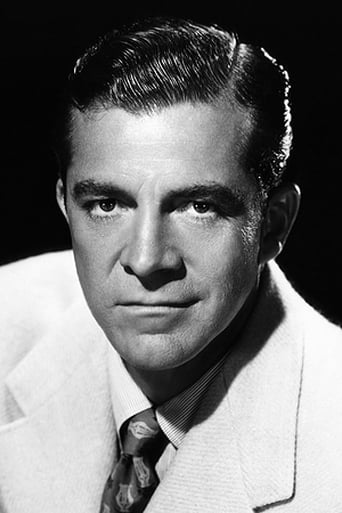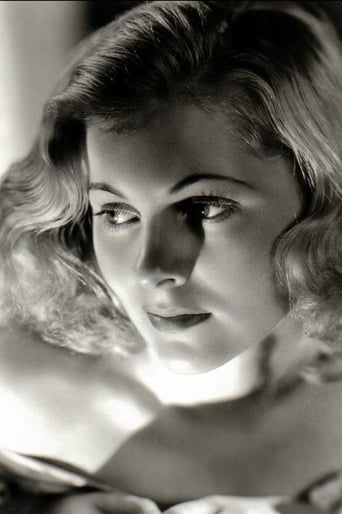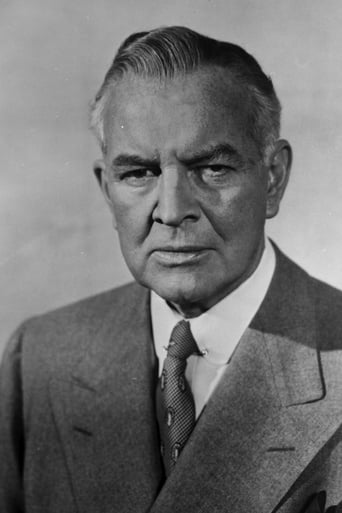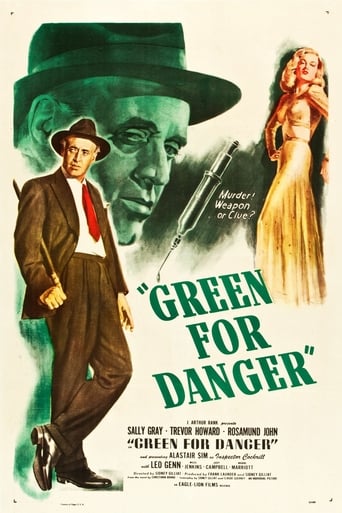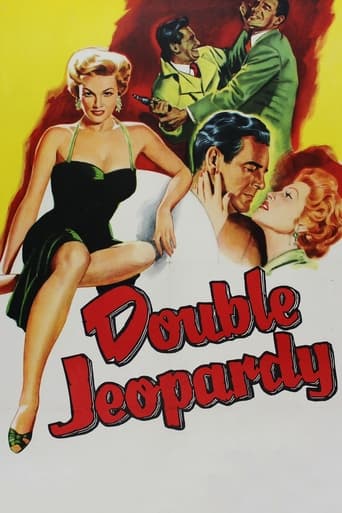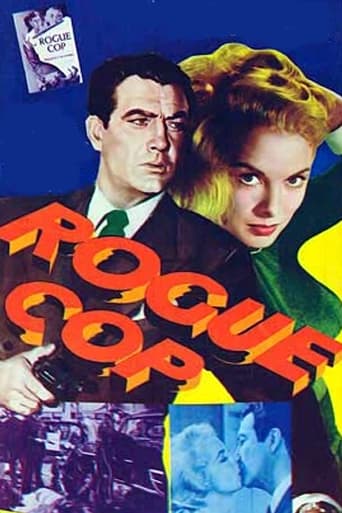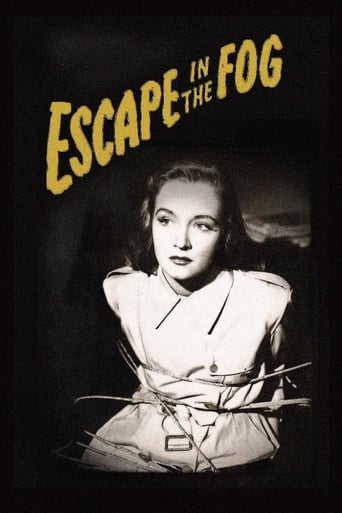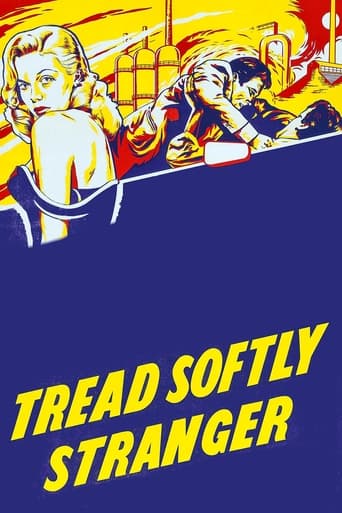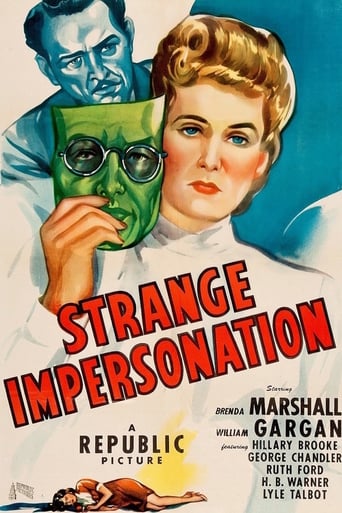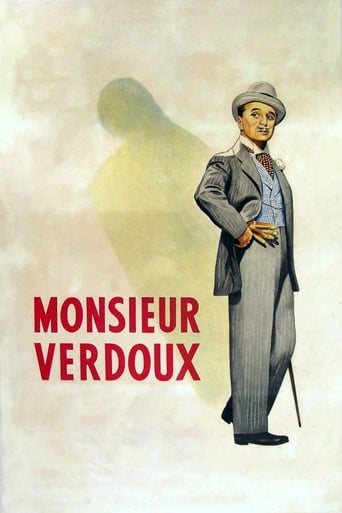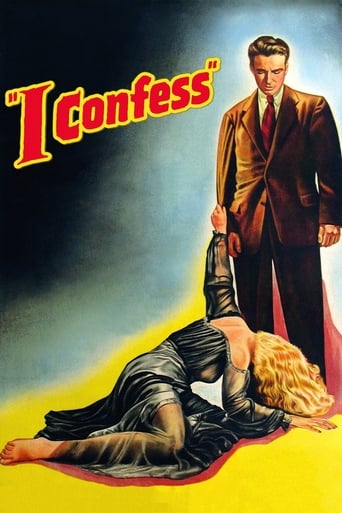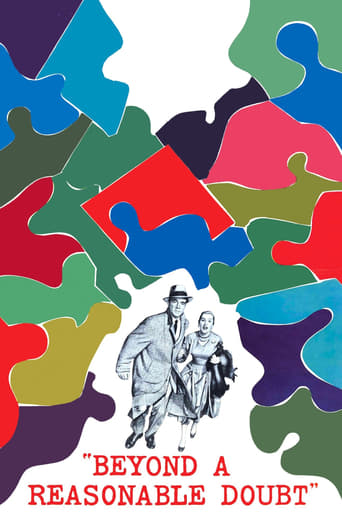

Beyond a Reasonable Doubt (1956)
A newspaper publisher, wanting to prove a point about the insufficiency of circumstantial evidence, talks his possible son-in-law Tom into a hoax in an attempt to expose ineptitude of the city's hard-line district attorney. The plan is to have Tom plant clues leading to his arrest for killing a female nightclub dancer. Once Tom is found guilty, he is to reveal the setup and humiliate the DA.
Watch Trailer
Cast


Similar titles
Reviews
I enjoyed this tale of a writer, Dana Andrews, who arranges an indictment of "circumstantial evidence" by picking an unimportant murder case out of the newspaper and, with the aid of the newspaper's editor, plants clues that point to him as the murderer. The editor, however, is busily taking photos with a "self-developing camera" of Andrews cheerfully planting the fake evidence.But -- the best laid plans. Andrews is convicted of the murder, but the editor dies in a car accident and burns up, along with all the evidence of fakery. That leaves Andrews pacing nervously back and forth on Death Row facing two eggs of hydrogen cyanide.His girl friend, Joan Fontaine, does everything she can to help him. When he explains the scheme, she enlists the aid of a detective Arthur Franz, to find any exculpatory evidence. Everyone is nervous.I can't say it's Fritz Lang's best American movie. I saw it in the El Camino Theater in San Bruno, California, and enjoyed it. It's still enjoyable but for a more experience and critical viewer, certain holes in the plot may be apparent.Also, Joan Fontaine, enchanting in her youth, here seems stiff and perfunctory, and wrapped up in the ugliest women's clothes imaginable. My God, the styles were terrible. And make up didn't help. They've tied her blond hair back into a severe bun or whatever it's called.Dana Andrews is his grim and solemn self, but he's older too, and he was in the grip of alcohol and looks puffy.For whatever its weaknesses may be, it's worth catching. It would have made a perfect episode on Alfred Hitchcock Presents.
Beyond a Reasonable Doubt (1956)An early wide screen black and white drama that marks the end of Fritz Lang's American career and also shows the winding down of two great stars, Joan Fontaine and Dana Andrews. The film is no send off, exactly, but it is slightly tired, as if the formula of movie-making needs a twist and it isn't here.That's not the point, of course. This is now the mid-fifties, crisis time for Hollywood, and with widescreen (and widescreen color) movies making a final jab at the rise of television. The plot is sensational, and not too far from what an extended early television drama might try, with mostly interior shooting and a staged (sometimes stagey) presentation. In all it's not Lang's best, and he was a master at both noir/expressionist drama and at getting to the human dilemma of fate and murder. Andrews and Fontaine are not a bad pair—both are matched in calm and sophistication, and beauty, even, though Fontaine seems like an accessory until the very end. Andrews rules the plot, which makes him out to be a writer desperate for a new story. So desperate he's going to pretend to commit a murder just to test the justice system.It's all so outrageous you want to believe it, though your mind says it just wouldn't happen. It's too convenient, and one man's suggestion from the newspaper turns out to be the other man's reality. Enough said!Oddly enough, this is an RKO distribution even after the studio's demise (I don't know the reasons there) but it might point to a less than perfect crew. Certainly the cinematographer, which Lang relied on greatly in earlier films, is no one with credentials. Likewise the editing and writing are fairly routine, even lackluster. And so if a movie that depends on some psychological intensity is really a bit of a grunt effort, whatever the star power involved, it's a bit doomed. So watch this if you are curious about any of the parts. I'm a fan of all three of the principles here, and so had to watch it. But I didn't walk away impressed.
Maybe not quite what it could have been, but recommended. This probably suffers most from what appears to be a low budget--and arguably a dearth of style from director Fritz Lang. But Lang could be quite flamboyant in other films, so perhaps the relatively straightforward style here is meant to suit the movie and its themes. And it's the story and themes that will have you talking afterwards: Though it's vaguely far-fetched and certainly contrived, this is quite the screenplay. I won't say anything other than the following: Dana Andrews plays Tom Garrett, a novelist who's persuaded by his newspaper mogul friend Austin Spencer (Sidney Blackmer) to pose as the suspect in a murder in order to prove the pitfalls of circumstantial evidence and politics in death penalty cases. Andrews eventually gets in over his head, and... well, see for yourself. Mildly underwhelming in route, "Beyond a Reasonable Doubt" nonetheless gathers a pretty good head of steam by its surprising climax. Dana Andrews gives a typically solid performance; if that sounds like slight praise, I don't mean it like that; he's a personal favorite of mine, especially for the work he did in noirs, and he seems today rather sadly under-appreciated, if not largely forgotten. Joan Fontaine is also on hand here as Susan Spencer, Garrett's fiancé and Austin's daughter. Overall, somewhat disappointing on the level of production, but otherwise very much worth a look for classic film fans.
Imagine an innocent man convicted for a crime he did not commit, being tried and found guilty. The laws of that particular state demand a sentence of death on the electric chair. After meeting the fate ordered by the verdict, the man goes to his death and when all is done, new evidence shows someone else was the real culprit. Is that justice?That is the point of Austin Spencer, a newspaper publisher, completely opposed to the death penalty. His own future son-in-law, Tom Garrett, a novelist, could not agree with him much more. Spencer wants to build a fake case with the help of Tom, in which a horrible crime in the news is brought to the attention of the police and the District Attorney. For that, Tom Garrett chooses the case of a burlesque dancer that was found dead and the case proves to be a mystery for the law enforcement people. Tom will act the part of the elusive man sought by the police as the killer.Austin and Tom fabricate a story that follows closely the real murder. Austin wants to document the way they prepared the fake case. Tom, reluctantly agrees to go along and pose as the assassin. His own wedding to Austin's daughter, the lovely Susan Spencer, might be in jeopardy. If Tom is condemned to die on the electric chair, Austin will have all the evidence to render the case for capital punishment for Tom a mockery of the system.Fritz Lang directed this RKO 1956 film. The director had a vivid imagination; evidently he was intrigued by the application of justice in his adoptive country, as shown in the magnificent "Fury" of his early Hollywood career. The screenplay by Douglas Morrow offers a satisfying courtroom drama with an ironic twist most viewers do not expect.Dana Andrews is at the center of the picture as Tom Garrett, a successful novelist in his own right, much in love with Susan Spencer. Mr. Andrews was an actor that delivered, as is the case here, although his style was a terse approach to his characters. Sidney Blackmer, a veteran actor himself, is also at his best with his take of the publisher with a conscience that wants to see the death penalty abolished in his lifetime. Joan Fontaine appears as Susan Spencer. Her role could be seen as supporting, because she is relegated to just adorn the film with only a few important scenes to her credit.The supporting roles are more interesting in the film. Barbara Nichols is perfect as the burlesque girl at the center of Austin Spencer's plans. Bob Hale, Shepperd Strudwick, Phillip Bourneuf, Ed Binns, and Joyce Taylor, among the large cast do a wonderful job in the film.Highly recommended for all Fritz Lang's fans.


